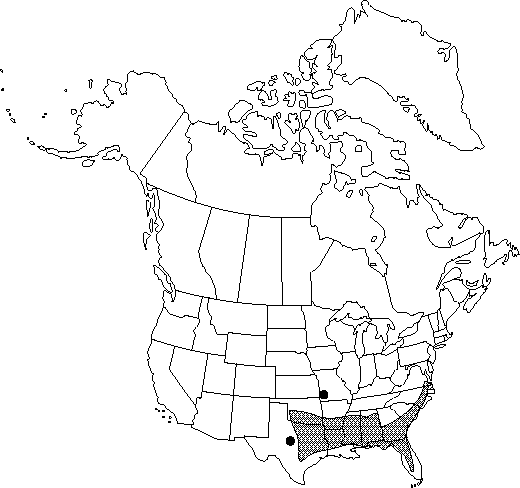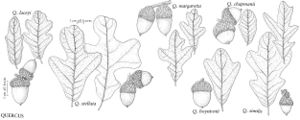Difference between revisions of "Quercus margarettae"
in J. K. Small, Fl. S.E. U.S., 355. 1903.
FNA>Volume Importer |
FNA>Volume Importer |
||
| Line 13: | Line 13: | ||
}}{{Treatment/ID/Special_status | }}{{Treatment/ID/Special_status | ||
|code=F | |code=F | ||
| − | |label= | + | |label=Illustrated |
}} | }} | ||
|basionyms={{Treatment/ID/Basionym | |basionyms={{Treatment/ID/Basionym | ||
|name=Quercus minor var. margaretta | |name=Quercus minor var. margaretta | ||
|authority=Ashe | |authority=Ashe | ||
| + | |rank=variety | ||
|publication_title=J. Elisha Mitchell Sci. Soc. | |publication_title=J. Elisha Mitchell Sci. Soc. | ||
|publication_place=11: 94. 1894 | |publication_place=11: 94. 1894 | ||
| Line 24: | Line 25: | ||
|name=Quercus stellata var. margaretta | |name=Quercus stellata var. margaretta | ||
|authority=(Ashe) Sargent | |authority=(Ashe) Sargent | ||
| + | |rank=variety | ||
}} | }} | ||
|hierarchy=Fagaceae;Quercus;Quercus sect. Quercus;Quercus margarettae | |hierarchy=Fagaceae;Quercus;Quercus sect. Quercus;Quercus margarettae | ||
| Line 48: | Line 50: | ||
-->{{#Taxon: | -->{{#Taxon: | ||
name=Quercus margarettae | name=Quercus margarettae | ||
| − | |||
|authority=(Ashe) J. K. Small | |authority=(Ashe) J. K. Small | ||
|rank=species | |rank=species | ||
| Line 61: | Line 62: | ||
|publication title=in J. K. Small, Fl. S.E. U.S., | |publication title=in J. K. Small, Fl. S.E. U.S., | ||
|publication year=1903 | |publication year=1903 | ||
| − | |special status=Endemic; | + | |special status=Endemic;Illustrated |
| − | |source xml=https://jpend@bitbucket.org/aafc-mbb/fna-data-curation.git/src/ | + | |source xml=https://jpend@bitbucket.org/aafc-mbb/fna-data-curation.git/src/f50eec43f223ca0e34566be0b046453a0960e173/coarse_grained_fna_xml/V3/V3_1039.xml |
|genus=Quercus | |genus=Quercus | ||
|section=Quercus sect. Quercus | |section=Quercus sect. Quercus | ||
Revision as of 21:24, 16 December 2019
Small trees or shrubs , deciduous, to 12 m, sometimes rhizomatous. Bark light gray, scaly. Twigs green or reddish, becoming gray, 1-2(-3) mm diam., glabrous. Buds reddish brown, ovoid, 2-3(-6) mm, apex obtuse, sparsely pubescent to glabrate. Leaves: petiole 3-10(-15) mm. Leaf blade obovate to narrowly obovate, (25-)40-80(-135) × 20-40(-80) mm, base cuneate to rounded-attenuate, margins moderately to deeply lobed, lobes rounded or spatulate, sometimes middle or distal 2 lobes compound, with secondary lobe on proximal side, divergent at right angles, forming cruciform pattern, secondary veins 3-5 on each side, apex broadly rounded; surfaces abaxially light green, with interlocking, erect, 2-4(-6)-rayed stellate hairs, velvety to touch, adaxially dark green, glossy, glabrous or sparsely stellate, not harsh to touch. Acorns 1-3, subsessile or on peduncle to 20 mm; cup deeply cup-shaped, basally rounded or constricted, (7-)9-12 mm deep × 12-20 mm wide, enclosing to 3/4 nut, scales loosely appressed, finely grayish pubescent; nut light brown, ovoid, 15-25(-30) × 9-13(-16) mm, glabrous. Cotyledons distinct.
Habitat: Deep sands and gravels, often in dense woods as understory or in open scrubland and pine barrens
Elevation: 0-600 m
Distribution

Ala., Ark., Fla., Ga., La., Miss., Mo., N.C., Okla., S.C., Tex., Va.
Discussion
Historical records for Quercus margaretta exist for New York, but no current population is known there.
Populations of post oak in east Texas (the Cross Timbers region) on sands and gravels exhibit characteristics somewhat intermediate between Quercus stellata and Q. margaretta; most of the trees at those localities have leaves with abaxial surface similar to Q. margaretta, leaf shape more similar to Q. stellata, and twigs somewhat intermediate between the two species in diameter and varying from tightly pubescent to glabrate. Acorn characters tend toward Q. margaretta as well. These populations have been treated as Q. drummondii Liebmann, the Drummond post oak. Similar intermediates occur sporadically throughout the range of the post oaks in southeastern United States, but they do not form such continuous and morphologically stable populations; perhaps the Texas material is best treated as a nothospecies, Q. ×drummondii.
Selected References
None.
